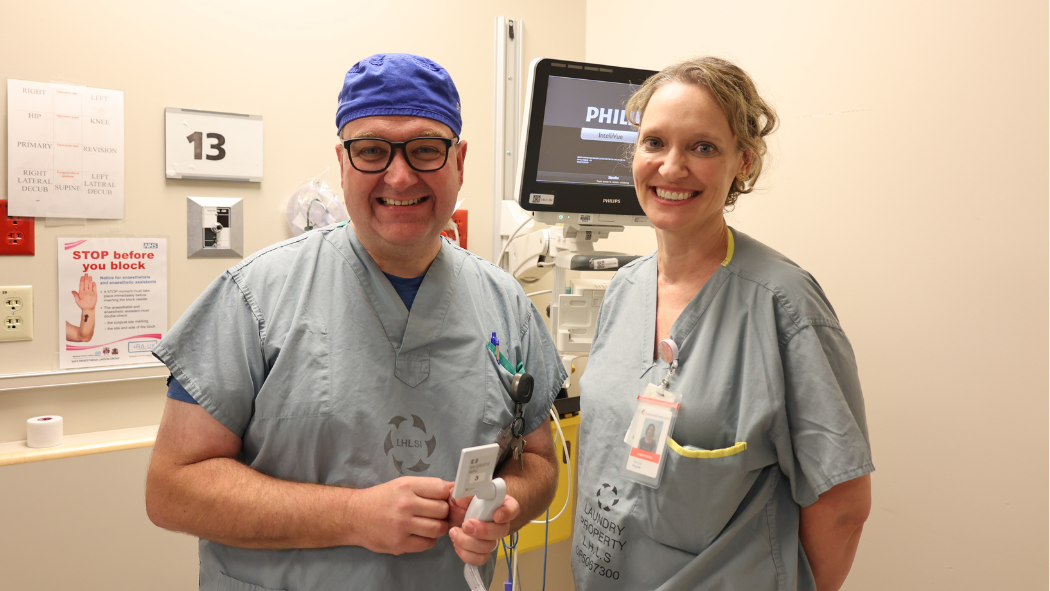
September 24, 2024
An international team of researchers involved in the Evaluation of the McGrath MAC (EMMA) trial, including those from Lawson Health Research Institute and London Health Sciences Centre (LHSC), have been awarded the prestigious John Smith Award for Best Paper by the Association of Anaesthietists (UK). The paper titled “A multicentre randomized controlled trial of the McGrathTM Mac video laryngoscope versus conventional laryngoscopy” explores whether video laryngoscopy is superior compared with direct laryngoscopy for elective tracheal intubation in the operating room.
Intubation is a technique that anesthesiologists, emergency physicians and intensivists use to keep a patient’s airway open by placing a tube into the trachea (windpipe). Intubation is often used in planned surgeries and critically ill patients.
In the case of the EMMA trial, researchers were specifically exploring tracheal intubation using video laryngoscopy in elective surgeries.
Traditionally, video laryngoscopy has been used for tracheal intubations as a back-up method to direct laryngoscopy, a method that has remained unchanged for many decades. Laryngoscopy is a procedure done prior to intubation, where physicians use a laryngoscope to guide an endotracheal tube (ETT) into the mouth or nose, voice box, and then trachea. Video laryngoscopy uses video technology to provide more advanced guidance through the process, while direct laryngoscopy does not. Although video laryngoscopy is used as the method of choice in more difficult intubation scenarios, the question remained whether video laryngoscopy could also be favourable in routine procedures.
Dr. Ruediger “Rudy” Noppens, lead researcher on the study and Interim Co-Department Head, Anaesthesiology and Perioperative Medicine at LHSC, and the EMMA trial team hypothesized that using video laryngoscopy for routine tracheal intubation would result in higher first-pass tracheal intubation success compared with direct laryngoscopy. This means they wanted to evaluate whether video laryngoscopy would be more successful than direct laryngoscopy in guiding the ETT into the trachea on a physician’s first attempt. In a multicentre randomized trial, 2092 adult patients were randomly assigned to either video laryngoscopy with a Macintosh blade (McGrathTM) or direct laryngoscopy.
The results concluded that the first-pass tracheal intubation success rate was higher with video laryngoscopy (94 per cent) compared to direct laryngoscopy (82%); showing an absolute risk reduction of 12.1 per cent. The study demonstrates that using video laryngoscopy improves first-pass tracheal intubation success in patients having elective surgery when compared to direct laryngoscopy.
“International airway management guidelines emphasize the importance of limiting the number of tracheal intubation attempts since the risk for potential complications increase with every attempt,” said Dr. Noppens, who is also an Associate Scientist at Lawson Health Research Institute. “The results support our original hypothesis, showing that using the McGrath is preferrable to the traditional direct laryngoscopy simply because the McGrath device reduces the amount of tracheal intubation attempts.”
The study also evaluated the performance of anaesthetists with differing degrees of experience with tracheal intubation. It found that those with less experience benefited more from using video laryngoscopy. Though the first-pass success rate of video laryngoscopy was also higher in those with more experience, the benefits were less evident.
This study remains the largest randomized controlled trial to explore the comparison of video laryngoscopy and direct laryngoscopy, providing an evidence-based foundation in support of the transition to more widespread use of video laryngoscopy.
“Emergency departments and intensive care units have been using video laryngoscopy as first choice for difficult, emergent intubations for some time now,” said Dr. Noppens. “However, our team hopes that the completion of our research will provide the groundwork for larger-scale adoption of this method.”
The team’s research also provided valuable insight into the importance of an interdisciplinary approach to airway management incidents.
“We learned that it is not just the instrument that enhances patient safety but the teamwork happening in the operating room in times of crisis. This has provided the opportunity to introduce a new initiative here at LHSC, the “Red Button Initiative”, where we educate all those in the operating room on how to respond to critical cases including airway management,” added Dr. Noppens.
Dr. Noppens and his team are currently working on exploring this interdisciplinary approach further in an effort to continue their work to enhance patient safety and crisis management through the lens of airway management.
The John Smith Award was announced on August 20, 2024, during the Airway Webinar of the Association of Anaesthetists of Great Britain & Ireland. The award itself is dedicated to Dr. John Smith and is intended to recognize the best paper published in Anaesthesia, the highest ranked journal in the field of anaesthesiology. The paper must be on the topic of airway management, with a focus on research, education and patient safety.
The achievement of receiving the John Smith Award reflects the team’s ongoing commitment to the advancement of airway management practice and the dedication to patient safety.
“Winning this award is a testament to the hard work and dedication of our entire EMMA team, especially those from the London anaesthesia team including Dr. Sonja Payne, Dr. Tim Turkstra, Lee-Ann Focesato, Dr. Jason Chui and Rob Meyer,” said Dr. Noppens.
